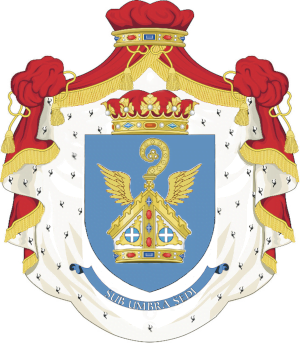The Principality of Sabourg was a tiny territorial entity, measuring approximately 110 km2 and recognised at the time as an independent sovereign state, following the approval of the first statutes and regulations, drawn up for the monks of the Abbey of Lerino in 1261, at the Cappellania di San Michele in Ventimiglia. The monks of the Principality of Sabourg ruled from 1261 to 1729, when they sold the Principality to the King of Sardinia. From 1730 to 1945, the territories of the Principality of Sabourg were administered by the Savoy Monarchy, i.e. the Kingdom of Italy. Since 1946, the municipality of Seborga has been counted among the municipalities of the Province of Imperia of the Italian Republic; in fact, the Republic unilaterally exercises the right of Protectorate conferred on the Savoy, as illustrated in the photo below:

‘Seborga over the centuries faithful to the Protecting Dynasty’
This is tangible proof that Seborga was not an integral part of the Kingdom of Italy, but a Savoy Protectorate.
This statue was erected in honour of King Umberto I 20 years after his death, in honour of the man who constituted the municipality of Seborga in 1896, as shown by the coat of arms of the Savoy monarchy, inscribed on the wall of the ancient abbey building, inside the cloister, as shown in the photo below:

Unfortunately, during the restoration of the façade, the blazon was painted blue, which evidently belonged to the Savoy family, because they alone administered the territory by virtue of the protectorate in 1896.
The path that we followed to reconstitute the Principality of Sabourg was studied, according to historical and theological sources, by proceeding to the constitution of a religious congregation in Seborga, in this case, the Monastic Order of Seborga, untied from the Vatican but incardinated in a religious body that had official relations with the Roman Catholic Church.
The ‘Polish National Catholic Church à Monaco’, which established the Monastic Order of Seborga, as a result of its legation with the Polish National Catholic Church based in Pennsylvenia, of which it is an official emanation, can claim the ancient right in place of the monks of Lerino and the Benedictine or Cistercian Congregation, and above all by the Vatican by virtue of the fact that, in our opinion, the Abbey of Lerino and that of Mont Majeur d’Arles lost the right of legation with the Principality of Sabourg as a result of the sale of 30 January 1729, having received payment from the King of Sardinia.
The deed of sale of 30 January 1729 was ineffective or null and void as a result of the failure to comply with the condition imposed by Pope Benedict XIII on the sale: ‘pay all debts and I will not opt for the sale’.
In fact, the Supreme Pontiff of Rome would become the holder of the vacant See of Prince Abbot from 1729 until 1929, the year in which he signed the Lateran Pacts with the Kingdom of Italy.
At this point, the Italian Republic would have been entitled to legally hold the permanent Protectorate over the Principality of Sabourg, which it did officially until 4 November 2020, the day on which the newly elected Prince Abbot, His Most Reverend Highness Giovanni Luca (born Gianluca de Lucia), legitimately installed and crowned on 28 December 2019, officially claimed the right to sovereignty over the Principality of Sabourg from the Prime Minister of the Italian Republic.
This epoch-making event is legitimised by the re-establishment of the Abbey of Sabourg, as a result of the right of the Monegasque religious congregation in Seborga. It is necessary to emphasise that this cult organisation, being an emanation of the Polish National Catholic Church, by virtue of the fact that this church was born out of schism with the Roman Catholic Church before the Lateran Pacts were signed, it is entitled to claim the right of the Vatican, abrogated by the initials of the Pacts themselves, which impose the renunciation of all territories outside the Vatican walls.
Lastly, we wish to emphasise that the citizens of Seborga, known as ‘seborghini’, i.e. those who were actually born in Seborga and have lived there for generations, five or six families in all, could have contested the birth of the Italian Republic and possibly held a local referendum to vote for a local governor, in order to initiate the birth of the Republic of Seborga.
Such an event could have asserted a legal value in the absence of the right of sovereignty exercised by the clergy.
CONSEQUENTLY
On 29 September 2019, with the advent of the Monastic Order in Seborga, the monks, tertiaries and converts, together with the clergy, legitimately re-established the ancient right of sovereignty of the Principality of Seborga, albeit without territorial possession.
Hence, no other legal entity has the right to claim legitimacy to govern the Principality of Seborga.


